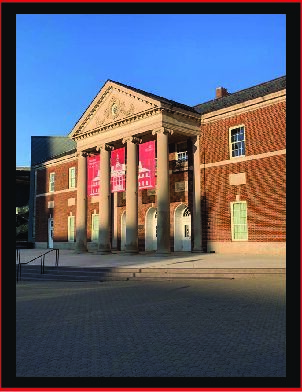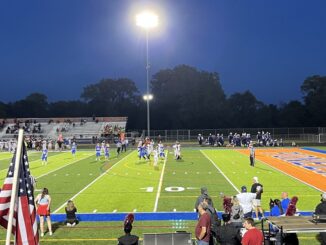
photo credit: Lilly Wood & Audrey Selsor
Senior year is like the last few chapters of a novel. The climax of the end brings about the fun, bittersweet memories created through the fun events planned to make the year memorable. However the end of the novel does not mean it is the end of the story. The last year of high school is a year of preparation for the next book in the series of a student’s life.
From college applications to graduation, there are a ton of decisions students must make to put them on the path to their future.
To some, senior year is the most appealing including memories of superlatives, breakfasts and graduation parties. However, there’s another thing that senior year brings to the table: college applications.
It’s expected that most people would choose in-state colleges, which offer a cheaper and close-to-home path for a higher education. Ohio features plenty of colleges, ranging from large to small. For students like Harish Mukkapati, a sophomore at OSU, larger colleges are the right choice.
“I like how large it is, and how diverse it is,” Mukkapati said.“I got to meet so many international students, and other students from across the nation. I was able to learn about their walks of life, and how different it is myself, coming from an upper-middle class area like Olentangy.”
Large in-state colleges, like Ohio State, have expansive campuses and high attendance. OSU totals an astonishing 61,677 students attending its main campus, ranking fourth in size nationally for public universities, according to The Ohio State’s University’s website. These colleges can provide high-quality programs and facilities like OSU’s reowned Wexner Medical Center, which is maintained its spot in the national rankings for programs like political science, pharmacy and numerous engineering programs. Perhaps on top of all is Ohio State’s sports dominance, especially college football.
Ohio State is often one of the most popular destinations for Olentangy Orange alumni, which suggests a positive repute for the college.
“While I was able to meet a lot of people, the nature of it is that a lot of people from high school (especially the AP group of students) will go to OSU. This means that OSU somewhat feels like an extension of high school. I also like the city-like nature of OSU, which allows for a far greater feeling of independence that may simply not be possible at smaller colleges,” Mukkapati said.
Though Ohio houses multiple large colleges like the University of Cincinnati, Ohio University and Kent state, Ohio State is the only one in the greater Columbus area. For many, moving even an hour or two away to other in-state colleges can be a detriment.
“The only regret I have going to UC is the distance from home,” said third year Cincinnati student Siva Kunapuli, who hails from Dublin. “I would say my experience is a seven out of a ten. At first it was hard to make friends. I personally found it similar to OSU except smaller.”
The University of Cincinnati has built a solid name for itself and a population of 46,710 students, according to the University of Cincinnati’s website. Popular for its distinguished co-op program, where students can alternate semesters working for jobs tied to their major and pay tuition, Cincinnati recently overtook Ohio State in the Niche national rankings, a solidifying feat for a large, reputable college.
Many students going to large in-state colleges often apply to out-of-state colleges making a choice can be a struggle.
“I do regret often not choosing Georgia Tech, but I feel being blinded by prestige is not a valid enough reason to pay out-of-state tuition. I chose OSU purely for cost reasons. $24k/year vs $60k+/year. Plus, the safety net of having a social network coming into OSU,” Mukkapati said.
As hard as it can be to decide with out- of-state colleges, it can be just as hard with smaller in-state schools, which can be a better fit for certain students.
“I truly believe that college is what you make of it. You can go to a smaller college like Bowling Green or Miami and be just as successful as going to an elite college like Georgia Tech or Stanford,” Mukkapati said. “It’s just that going to these elite colleges means that you will be more likely to be surrounded by those with insane work ethic, and you will probably adjust to that cutthroat environment. One can do the same at smaller institutions, but the onus is on them to make the effort.”
At the end of the day, it can’t be denied that the college admission process is an arduous task. Guidance from former or current college students can help give some perspective on what one is looking for in a college.
“I would suggest visiting the campus with a friend instead of taking a tour because you can explore more, and go into dorms and classrooms as well, not just seeing things from the outside,” Kunapuli said.
Whether it’s because of movies or first- hand experience, college has an additional meaning in society of a fun journey of parties, freedom, and self-discovery. Yet, those themes may not be carried into certain colleges as much as people think, according to some.
Understand that you must not have any hope of reinventing yourself or something coming into OSU, it’s just more of the same as high school. If you were friendless and socially awkward, that’s not changing all of a sudden when that one comes to OSU, where everyone they knew at Orange is also going,” Mukkapati said. “Also, academics (especially STEM courses) are incredibly more difficult at the college setting, professors do not hand hold you like high school teachers do. I never put effort in high school, but now I invest the majority of my day and frequently have all- nighters just to finish work and understand content.”
As seen, large in-state colleges mean many things. And for the many contemplating to pick them, they can observe advice from graduates like Harish Mukkapati and Siva Kunapuli to find the best path for their collegiate future.
At the brink of adulthood, high school students are told that they are supposed to know what they want to do with the rest of
their lives. The reality is most students have no idea what step to take next. Talking to loved ones can help students come to a consensus, but in the end these students are the ones deciding their own fate.
High schoolers get to senior year and come to a crossroad. Life after high school is a big question mark dangling over their heads pushing for the answer to the future. For most students the answer is to attend a college or some sort of further education before they start their job or trade.
There are a lot of decisions to make when trying to pick the college that fits best for a particular student. Major questions regarding the location of the school, the price, the size, or if a certain major is provided are all things that seniors have to consider.
“Choosing a college is stressful, and ensuring that you make the right decision can often feel like a daunting task,” managing editor and contributing writer at FastWeb Shawna Newman said. Fast Web is a website where students can find scholarships, information on financial aid, internships and more.
A good place to start a college search is deciding the size of college that fits best. The size of a college is what determines the size of a college is what determines the student’s overall experience at the school of their choice. The size of the school dictates the size of the classes along with the feel and intimacy of the campus.
Medium sized schools are a good balance of large and small colleges. Medium sized schools usually have a large enough student body that makes it easy enough to blend in with the crowd but small enough that it is relatively easy to make friends.
“I really liked the size of Miami and the campus,’’ math teacher Matthew Berndt said. Berndt explained that he had a great social experience throughout his college career due to feeling safe on campus and being able to work alongside his studies.
Miami University is one of many mid- sized schools located in Ohio. Miami has a total enrollment of 19,264 students and an 88.6 percent acceptance rate as of 2022, according to Niche, a college search website.
Berndt said he chose this university due to his appreciation for the campus’s beauty and its smaller feel. “It was far enough away from home that it felt like I was going away for college but close enough that I could get home quickly if I needed or wanted to,” Berndt said.
Academic wise, mid- sized schools have a variety of class sizes depending on the level of the course; smaller classes are usually more advanced and in depth, while larger classes are the more basic courses that most students are required to take.
“The academics were hard, and I wish I was more prepared going into college in regards to how to study. I do appreciate the academic rigor of Miami and feel that I received a top-notch education,” Berndt said.
Students who go to mid-sized schools usually are close enough to their professors (depending on the class size) that the professors know their names but not so close that students become friends with them.
“I liked the accessibility to my professors and the facilities on campus. I liked how college has something for everyone, and Miami did a great job of making sure students found their niche,” Berndt said.
There are many other mid-sized schools in Ohio other than Miami University. Some of these colleges include Ohio University, University of Dayton, Case Western Reserve University, and more.
“I ended up going to Indiana University for two years and Ohio University for three years,” 2013 OOHS graduate Taylor Agler said.
Ohio University is another mid-sized school in Ohio. The school has a student enrollment of 21,152 and an acceptance rate of 89 percent as of fall 2022, according to US News’s website.
“I had a great academic experience. I really enjoyed big lecture hall style classes because it was on me to learn the material, and I ended up learning best that way,” Agler said.
Another major deciding factor for a lot of students is sports. Sports are a great way for a student to get a great education on a scholarship.
“Playing college sports completely impacted my college experience. Every day was focused on being a college basketball player, and then in my free time I got to sprinkle in activities of a normal college kid,” Agler said.
Agler played basketball all throughout her highschool and college career. Playing sports in college looks a lot different than students who are just focused on their academics.
“It was really busy, but I wouldn’t trade that experience for anything. I was so lucky to have the opportunity and I met my best friends playing a sport I love while going to school on a scholarship. I would recommend college sports to anyone thinking about it,” Agler said.
College is a great opportunity to meet new people and a great way to do that can be through sports whether it is for the school or intermural. Sports are not the only way to meet new people though. This is because at mid-sized colleges it is relatively easy to join clubs, study groups, etc.
“Most of my social outings were with my teammates, but that speaks to the importance of being involved while at college. Join a team, a club, Greek life or a study group. Getting involved is the bestway to immerse yourself in the social scene,” Agler said.
Mid-sized schools are perfect for a student who wants to be part of the crowd but has easy access to join social groups and to meet new people. Students who are drawn to having an independent academic career that allows them to easily seek out help should look more into mid-sized schools and how that would work for them.
For some the hustle and bustle of a large or medium sized college can be overwhelming. The size of these schools force students to have to put themselves in situations to meet people, such as joining clubs, teams, etc., which can be a difficult task depending on the person. These students might find that a smaller school is the better choice to further their academic career.
Senior year; a bittersweet combination of delight at how near the end is and desolation at knowing a stage of life is nearly over. With new chapters ahead, pursuing another level of education is the most common next step.
It may seem that the amount of decisions needed to be made is never-ending. For those who are planning on attending college, figuring out what schools to apply to can be difficult. University applications, including the Common App, usually open at the start of August, beginning with the academic year.
For someone who is searching for a more personalized and intimate learning environment, small colleges typically have fewer students than larger universities. This can make it easier for students to connect with faculty members, get involved in extracurriculars, and build relationships with peers.
“We are a diverse set of students coming from various backgrounds, and settings and we all have such unique experiences. We can all learn from each other and grow as people,”Current PharmD student at Ohio Northern, Dylan McWilliams, said.
Ohio Northern University (ONU) is a private, comprehensive university located in Ada, Ohio. It was founded in 1871 and has a total undergraduate enrollment of around 2,400 students. The rural location of ONU may not be ideal for students who enjoy the hustle and bustle of city life, according to Ohio Northern University’s website.
“The one thing I would change, if I had to pick, would be the location. We are in rural Northwestern Ohio, and it was a big culture shock for me when I first arrived,” McWilliams said.
While ONU is located in a rural area, there are still plenty of things to do off campus.
“You can go to Lima or Findlay. Columbus is also only an hour and a half away, so many students will go there if they want to have a day off from studying,” McWilliams said.
However, there are many opportunities to get involved in campus life thanks to the school having a strong focus on experiential learning. The university offers a variety of opportunities for students to gain hands-on experience in their chosen field, including co-op programs, internships, and research opportunities.
“Literally right before the pandemic started in March 2020, I studied in the Amazon Rainforest in Peru. During that week, I was able to learn about natural medications from a local shaman,” McWilliams said.
ONU is also home to a number of student organizations and clubs, including fraternities, sororities, athletic teams and academic clubs.
“I have had so many opportunities to expand my knowledge base as well as meet others within the profession. Here at ONU, we have over 200 organizations. If you can dream of it, it can be an organization here!” McWilliams said.
At ONU, the Raabe College is what sets the university apart from others. The ONU name is well known and there exists an extensive alumni network all around the country.
“There are many directors of pharmacy who will hire a new graduate because they are a polar bear. Our education here at ONU truly sets us up for success,” McWilliams said.
Overall, ONU offers a well-rounded education emphasizing academic rigor and hands-on learning. If someone is interested in attending Ohio Northern, visiting the campus is a great way to learn more about what the university offers.
“I would tell anyone about ONU; the campus fits many different personalities. I never would have thought I would attend a small university, but it has been life-changing for me,” McWilliams said.
The decisions made in senior year put students on a trajectory that sets up their future. The size of a college is a broader decision to be made, but it is still a major factor in the next part of a student’s life. Although the college application process can be daunting, once students get to graduation, the back cover of the book to their childhood is finally closed; leaving the reader on a cliffhanger of what the next part of their life entails.


